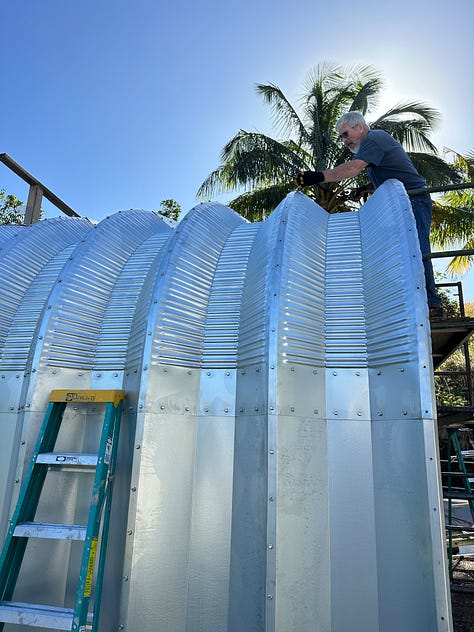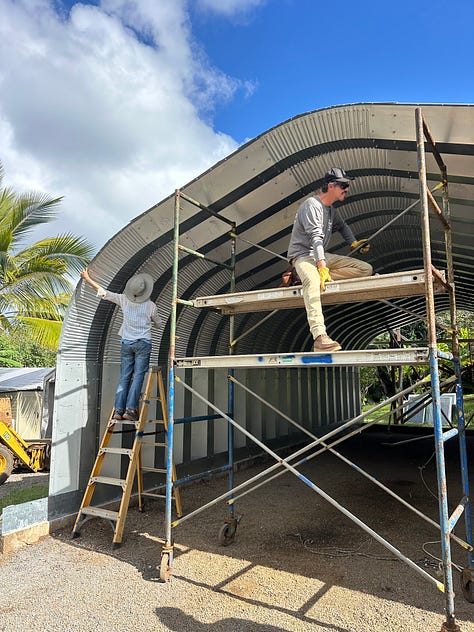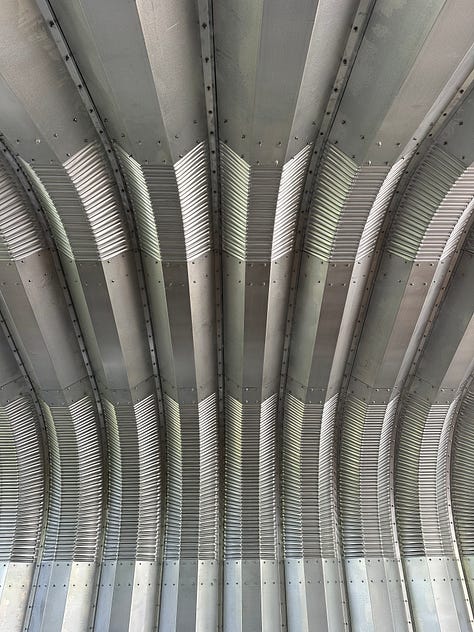Staying Rooted in the Real: Place, Process, and Presence
AI stole my voice, influencers misread the science (again), a horse taught me botany, and I raised a barn.
Dear friends, you can no longer trust the sound of my voice. Read till the end to find out why and see a new video work I’ve created to address this issue.
But first, I want to talk about community as a ‘methodology,’ my experiences of it here on Maui, and some unexpected discoveries—including how horses use herbs—while researching a current project.
I’ll also expose another recent social media menstrual myth that was sent my way, and break down the fascinating but extrapolated science behind it.
I’m leaving Meta platforms gradually (for some of the above reasons)—come find me on Bluesky instead of Instagram.1
Community as Lived Methodology
Recently I saw a post on Bluesky by an academic historian who was requesting help from his fellow ‘skeeters.’2 He was looking for scholarship about “place-based methodology & the value of visiting and experiencing spaces/environments we write about.”3 I suggested he consider creative practices—and artist residencies in particular, which facilitate exactly the kind of research he is inquiring about. I was making an argument for artistic practice as research—something very often overlooked in academia and which I won’t shut up about as a process-based artist.45
More broadly than my work, though, creative residencies emphasize reciprocal knowledge exchange, rather than one-way extraction.6 Reciprocity should be an important (decolonial, even) aspect of creative research ethics in such ‘place-based’ approaches. As artists and researchers, we should ask ourselves: What do I give back to the community I’m engaging with? Does the relationship extend beyond the project, or is it merely transactional?
For me, relationship-building as part of my creative practice is intentional, rooted in immersion, and sustained over time. You cannot rush a relationship, and really can’t rush community building. Community itself is a lived method, beyond formalized academic fields. I’ll expand on this in a moment, regarding my current experiences on Maui. In this light, I enjoyed reading the recent Substack post by Green Dreamer Kaméa, who wrote that, “Indigenous and local languages and ways of being, knowing, and living emerge from place.” Note that they are intertwined, from the perspective of what Kaméa explains as “biocultural diversity” and revitalizing the ‘real.’7
The Asensical Nature of Social Media
Why is it important to revitalize the ‘real’ (especially in research)? The notion of community is increasingly outsourced to digital platforms that capitalize on our need to connect and understand each other, often leading to misunderstanding and distorted facts.
Social media operates as a proxy for in-person, firsthand interactions, but in a programmed and highly targeted, second-, third- or infinite-handed way, depending on how many times content is recirculated. Its specific accuracy is diminished as human storytellers and the algorithms that utilize their stories shift the shape of the information over time (keep this in mind when I discuss the menstrual myth).
Social media is also largely asensical, operating without direct touch, taste, smell, proprioception, etc. and is thus registered through asensical means (our imaginations).8 But we cannot even trust our senses that online platforms rely upon: sight and sound. This hit home when my cousin recently messaged me: “Omg, I heard an ad for a skin cream today. I swear it was your voice. Was it??” More on that shortly.
Barn Raising and the Power of Presence
In-person community safeguards against vulnerability through direct accountability—face-to-face interactions that build trust in tangible ways. Rooted in daily experiences of place, relationships, and local ecologies, community emerges as a lived system of mutual reliance, fostering belonging and responsibility. Unlike the surface-level gestures of social media, this form of engagement cultivates a deeply integrated sense of identity. It is shaped by acts of generosity that bind us to one another, guiding moral decision-making in what some scholars describe as “ethics in action.”9






This past month, I participated in a barn raising on my dad’s farm on Maui. It was three days of my life set aside to help assemble 20 galvanized steel/aluminum alloy arches together one by one, nuts and bolts in hand. My fingertips were tenderized by the end of it and are still peeling, a fleshly badge of my worker status.
We were a team of seven, with varying levels of experience on construction sites but equal willingness to be useful. There was no hierarchy or assigned job task, simply doing what needed to be done. My dad had a vision, of course, and the manufacturer’s plans but we were each able to take initiative on various tasks. Sometimes I climbed the scaffold to pull the rope and hoist a new arch, sometimes I scaled a ladder to nut a bolt held in place by another person, and sometimes I simply wandered around picking up nuts and bolts that had been dropped on the gravel. This rotation of responsibilities ensured that each person felt needed. This is how a well-functioning community feels—like many hands in a kinship-structured organism. My dad worked as a building contractor for many years, so his particular skill in ‘place-based methodology’ is finely tuned to the land and community here.
I’m also here working on my ecoartspace Australian Dialogues project, exploring Australian plant species that have become naturalized and culturally integrated in Hawaii.10 It’s a project that bridges the fluid cultural expanse of what indigenous futurist and artist-researcher, Dr. Léuli Eshraghi calls The Great Ocean (instead of the Pacific).11 I’m interested in the plant species that have followed human pathways, particularly between Australia and the Hawaiian Islands. This rhizomatic cultural vitalism across the world’s biggest ocean fascinates me, as these locations feel like home to me in a kinship sense (the same as my grandmother’s house always felt like home). They have both become part of my identity after spending significant amounts of time living in each place.12
I walk my Maui neighborhood daily, often taking my aunt’s dog, Shiloh, with me. Shiloh likes to stop and gather the news from the many species that leave their olfactory signals, while I look and listen around. One day, as we approached my favourite cliffside, I recognized the Australian pine by sound before sight—the hush of its branchlets sweeping trade winds that had just returned after the previous week’s storm.
Taking a moment to record audio of the tree’s movement, I encountered a horse chewing on some of the overhanging foliage. It didn’t ingest much, so I wondered if this was an equine breath freshener or something. It whipped its tail back and forth, and the sound of the whooshing was identical to the sound of the swaying branchlets. Then I remembered the latin name for the plant: Casuarina equisetifolia. Curious, I researched and found that Casuarina equisetifolia—meaning “resembling a horse’s tail”—has thirst-quenching properties. It seems the horse knew something I didn’t:
“…its red sap is drinkable, should you ever need potable water… the gum of the tree is edible and was collected by the Aboriginals of Australia, where it is native… The branchlets can be chewed to moderate thirst… The young female “cones” and stems are also chewed to relieve thirst...”

The author goes on to explain that, “The Aboriginals knew the tree always meant water one way or another. The tree also played a role in the mysticism of many of indigenous people… Tahitians believed they arose from warriors who died in battle, killed by clubs or spears made from the Australian Pine. The warriors’ hair became the foliage and their blood oozed forth once more as the red sap.”13
Ah, blood and myth. Such rich territory.
Menstrual Myths and Scientific Misconceptions
Let me now segue to another recent concept around menstruation circulating online: that it is a natural form of detox and those of us with a uterus who don’t properly menstruate are apparently building up toxins. Menopausal and amenorrhoeic individuals, as well as men, must be really fucked, then—and one study I found could be read to suggest as much.14 Next we’ll be told that men who don’t ejaculate enough are also filling up with poison (I’m sure that belief exists somewhere).15
Setting aside the sass for a moment, which toxins, exactly?
Menstrual fluid has been found to contain environmental toxins like PFAS (“forever chemicals”), as the study I mentioned above demonstrated. Because PFAS chemicals bind to blood proteins, they are excreted during menstruation. However, the takeaway was not “ditch your birth control and bleed out the toxins” but rather that menstrual blood loss may skew epidemiological measurements of PFAS exposure.16 Extrapolating from this to suggest menstruation is a purification process is misleading. This is, however, what social media influencers are attempting to push.17
When referencing scientific studies, understanding precise arguments that the authors are making versus cherry picking tidbits of information that support one’s hunch (or bias) is what distinguishes actual research from bullshit baked in half-truths. Misinformation about ‘menstrual detox’ is being used to sell products like tea blends. But, this reductive, capitalist take on the real research is problematic from both a cultural standpoint as well as a scientific standpoint.
Such myths feed into long-standing stigmas about menstruation—namely, that it is dirty, polluted, and even poisonous. Some biomedical researchers actually still believe in the falshood of ‘menotoxins’—a notion used recently to argue that menstrual blood is instrumentalized to kill men. Helena Marinaro, a researcher studying menstrual stem cells, had her paper rejected by a journal because a reviewer genuinely believed this egregious nonsense.18 In academia, such bias can be challenged; on social media, misinformation runs unchecked, faster than a horse at full gallop.
Echoes of Me: AI and the Shifting Boundaries of the Real
Back to my voice being stolen. It turns out that an AI-cloned version of my voice has been used to sell a skin cream I’ve never heard of. This kind of digital disembodiment is accelerating, making it ever more essential to cultivate real, accountable communities—where presence, reciprocity, and embodied experiences serve as counter-force to the growing tide of misinformation and manipulation. While I am not against AI as a tool for creative exploration, I do oppose its use for corporate capitalist exploitation. The unchecked commercialization of AI-generated content amplifies misinformation and undermines personal identity, as I’ve just exemplified.
As a playful way to reclaim my voice, I decided to steal it back. I downloaded the ad, extracted the audio track, and reworked it into a spoof—repurposing video performance segments from an older artwork where I actually made a skin cream in a lab. Ironically, that work was itself a critique of the beauty industry. You can watch the 15-second video below.
I leave you here with an exciting announcement: I’ve just been awarded a Social Sciences and Humanities Research Council of Canada two-year Postdoctoral Research Fellowship at Simon Fraser University, and in a few short months will be joining the SFU School of Interactive Arts and Technology in the criticalmediaart lab with Dr. Gabriela Aceves Sepúlveda. Gabriela’s lab is focused on feminist media art. Vancouver, here I come!
Please come over to check out the bluer skies: https://bsky.app/profile/whitefeatherhunter.bsky.social
Bluesky users have decided that to post on Bluesky is to ‘skeet’ (as in, a ‘sky version of ‘tweet’ since Bluesky is the left-leaning replacement for X/itter). ‘Skeet’ is also slang for a jizz shot, reflecting the male distinction on the platform. Read about that fascinating etymology here: https://www.dictionary.com/e/slang/skeet/#:~:text=What%20does%20skeet%20mean?,of%20excitement%20like%20%E2%80%9CYay!%E2%80%9D
His username is @tluneau.bsky.social if you’re interested.
My keynote lecture last month at University College Cork was precisely to emphasize this point.
What is a process-based artist? In my case, it is an artist whose practice engages in experimental inquiry through novel materials and methods, and whose various (mostly unforeseen) ‘outputs’ are generated directly from those processes. Similar to craft in some ways, but not primarily object-based, and similar to science in some ways, but not primarily hypothesis-based. Instead, the process of research-creation is the main art ‘object’, moreso than what is produced, and any material objects are peripheral to that (they can be conceptually and aesthetically intriguing). This is why I work in video performance often, showcasing my process (and the thinking behind it) as the art, as well as the processes of the materials I work with: cells. This is intentionally political, challenging still-existing hierarchies in art and academia that assert the value of product over production, idea over material, etc. Particularly in academia, producers are often denigrated as merely technicians, invisibilized, and the credit given to the so-called ‘solo’ artist who presents the final objects. This truly outrages me, as a technical expert in at least two fields, a former craftsperson, and a class-conscious creator—I have fought against this for years.
Given, my experiments are exciting in part because of their potential wider applications, which I don’t have time to explore fully within short timelines of grants, exhibitions, publications, etc.—so, I generate prototypes and proof-of-concept one-offs. This is what I’m most interested in, and this method is developed over a research period (typically an artist residency), during which I immerse myself fully in technical tweaking, local materials, local meanings, community participation/ collaboration, and see what comes of it all. Ultimately, the final product sits in the realm of waste for me—much of my experiments end up in the biohazard bin and incinerated, under strict monitoring. They aren’t for sale. But the process videos are, as exhibitable objects.
Research, method, and scholarship have a long history of being extractive from communities, something the discipline of anthropology has a particularly troubled history of—but also artists and arts communities.
Please visit and peruse this wonderful Substack, here:
Our virtual disembodiment is augmented by the astounding capacity of human imagination, which marketers (and influencers) know is manipulable. Manipulability can be a gift, as it holds hands with creativity; artists often use brain tricks to foster random, new ideas—think of Surrealist games. But it is also a point of vulnerability to be extremely cognizant of, especially now in a world of Deepfakes.
I have heard this term used loosely in academic circles. It may originate from this source: https://www.wiley.com/en-us/Ethics+In+Action%3A+A+Case-Based+Approach-p-9781405170987
This is for an upcoming exhibition at SOUTHERN FOREST ARTS in Bibbulmun/Pibulmun Noongar Boodja (just outside of Boorloo/Perth, WA).
You can read more about this in the limited edition book, Indigenous Aesthetics and Knowledges for Great Ocean Renaissances published by Common Room Editions, ISBN 978-0-6488130-3-3. Thank you, Santiago Rentería for gifting me this book in 2023 after it was just published.
I have been visiting my dad on Maui since 1989. The first time I lived on Maui was in 1992, and have spent varying periods of time here since then. I lived in Western Australia off and on for five years during my PhD.
More here: https://www.eattheweeds.com/australian-pine/
For more, see https://pmc.ncbi.nlm.nih.gov/articles/PMC9876536/
Though, if they attempted this form of detox in Mississippi, they would have been fined $10000 if the “Contraception Begins at Erection Act” had passed: https://www.billtrack50.com/billdetail/1795563
The authors of the paper I mention conclude that, “Epidemiologic data provide compelling evidence for the role of menstrual bleeding on PFAS elimination. Studies over the past decade have generally reported lower PFAS body burden among individuals currently menstruating and those with heavier menstrual flow. Given these implications, further research is warranted on menstrual bleeding as an elimination route for PFAS in environmental epidemiology...” https://pmc.ncbi.nlm.nih.gov/articles/PMC9876536/
Dr. Jen Gunter has effectively addressed this idea of menstruation as detox on her Substack, The Vajenda. However, she misses on a couple of things. She claims that, “What comes out of you is regular blood, the same blood I would get if I drew a sample from a vein in your arm, mixed with endometrial cells, and the flotsam and jetsam it picked up along the way.” Menstrual blood is not the same as venous blood; proteome studies have demonstrated that menstrual fluid contains hundreds more proteins than venous blood. The authors suggest that, “Identification of unique menstrual blood proteins should aid the forensic community in distinguishing menstrual blood from circulating blood.” You can read more about that here: https://pmc.ncbi.nlm.nih.gov/articles/PMC3494145/ The rest of her information on the topic is excellent, though:
I wrote about this in my thesis. You can download the whole damn thing here: https://research-repository.uwa.edu.au/en/publications/the-witch-in-the-lab-coat-doubling-doubling-toiling-and-troubling





Kudos, but I don't even know where to start first! So many gems and nuggets here. I guess I'll start with congrats on your recent success all over! And, how random that you discovered that your voice was used. It's creepy that happened.
I educate women about perimenopause and am a women's health advocate so any women's health topic catches my eye. I liked your coverage of menstruation and that catch about menstrual blood being same.
FYI, found you via a comment you left on another post this morning 👍. I'll link up on Bluesky, just getting started there.
Love all these little, detailed, thoughtful reflections. They're different but all interlinked.